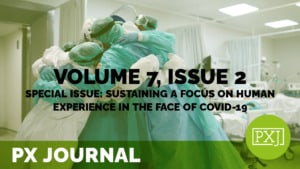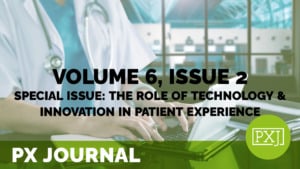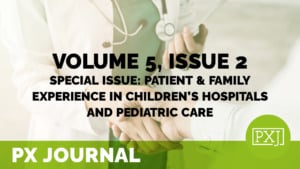PXJ Article
Showing 97–112 of 563 results
-
 Patient Family & Community Engagement
Patient Family & Community EngagementChildren’s experiences of hospitalization over time: An evaluation of using poetry and creative writing by children to assess their experiences of hospitalization
Learn more -

Chronic pain, vulnerability and human spirit while living under the umbrella of COVID-19
Learn more -
 Quality & Clinical Excellence
Quality & Clinical ExcellenceCo-designing of Patient Safety Incident Disclosure Process in Primary Healthcare System in Qatar
The importance of disclosing a patient safety incident to the patient involved is recognized. In Qatar, there is no legal requirement for disclosure. The primary health care system in Qatar includes 30 health centers located around the country, managed by the Primary Health Care Corporation (PHCC). Over 63 nationalities of staff deliver care in the
Learn more -
 Policy & Measurement
Policy & MeasurementCo-developing a Paediatric Patient Reported Experience Measure: The Perspectives of Children and Young People
Paediatric Patient Reported Experience Measures (PREMs) are tools that capture what children and young people (CYP) value in their healthcare and promote their involvement in clinical decision-making. A standardised paediatric PREM could improve quality of care for CYP across hospital settings, but CYP are rarely included in the development of PREMs. This study aimed to
Learn more -
 Innovation & Technology
Innovation & TechnologyCo-producing healthcare in a volume vs. value-based healthcare system: perspective of a parent of a patient and a health professions’ educator
Learn more -
 Innovation & Technology
Innovation & TechnologyCo-production development of a decision support tool for peers and service users to choose technologies to support recovery
Peer support specialists (i.e., lay interventionists representing one of the fastest-growing mental health workforce) are increasingly using technologies to support individuals with mental health challenges between clinical encounters. The use of technology by peers has been significantly increased During COVID-19. Despite the wide array of technologies available, there is no framework designed specifically for peer
Learn more -
 Innovation & Technology
Innovation & TechnologyCo-production of the quality of patient-centered outcomes research partnerships instrument for people with mental health conditions
Mounting scientific evidence over the past decades in the field of psychiatry has shown community engagement in research produces more relevant research, increased uptake of research findings, and better clinical outcomes. Despite the need for the integration of community engagement methodologies into the scientific method, doctoral and master’s level competencies in the field of psychiatry
Learn more -
 Policy & Measurement
Policy & MeasurementCollecting child-patient feedback: A systematic review on the patient-reported outcome measures for hospitalized children
Learn more -
 Culture & Leadership
Culture & LeadershipCommunity: The true driver of excellence in human experience
The idea that we are a community first, a community of people from a breadth of backgrounds and experiences, from all corners of our world, has been the foundation on which our work has been built, our efforts motivated, our research driven and our hope inspired. It is a tapestry of possibility, grounded in evidence
Learn more -
 Policy & Measurement
Policy & MeasurementComparing patient experience survey scores between telehealth and in-person ambulatory pediatric subspecialty visits
To determine the effect of encounter methods on patient experience, we evaluated patient experience survey data comparing scores between telehealth and in-person visits and pre-COVID-19 and COVID-19 time periods. Pediatric subspecialty visits were either in-person or via telehealth and received the same 16-question patient experience survey. Top box (5/5) scores were compared between in-person and
Learn more -
 Policy & Measurement
Policy & MeasurementComparing psychiatric care experiences shared online with validated questionnaires; do they include the same content?
Learn more -
 Patient Family & Community Engagement
Patient Family & Community EngagementConceptual frameworks and degrees of patient engagement in the planning and designing of health services: A scoping review of qualitative studies
Learn more -
 Culture & Leadership
Culture & LeadershipConceptualising multiple conditions in Australia: First steps to systemic change to meet the needs of people with serious long-term illnesses
Learn more -
 Culture & Leadership
Culture & LeadershipConcern for the patient’s experience comes of age
Learn more -
 Culture & Leadership
Culture & LeadershipCondition Help: 10 years of experience enhancing our culture of family engagement
Learn more -
 Infrastructure & Governance
Infrastructure & GovernanceConsidering shared power and responsibility: Diabetic patients’ experience with the PCMH care model
Learn more